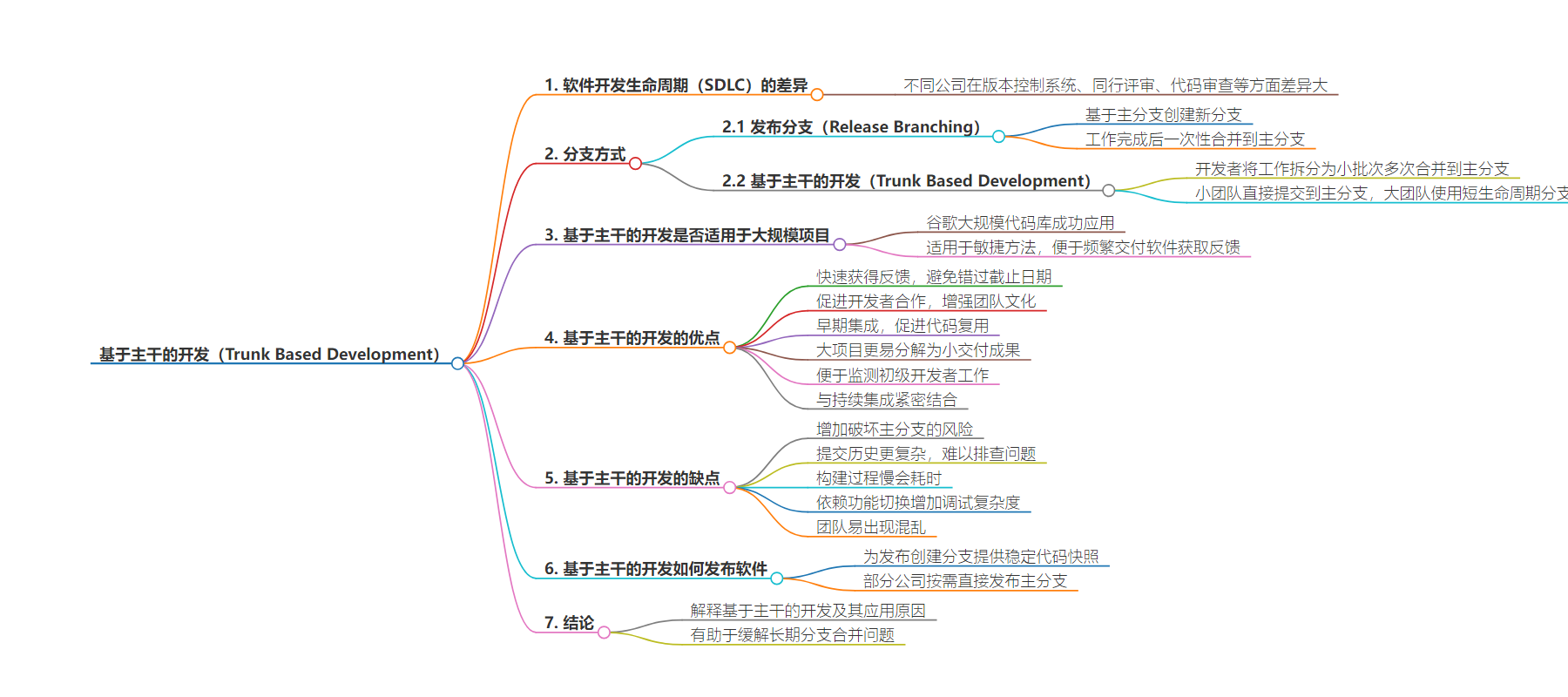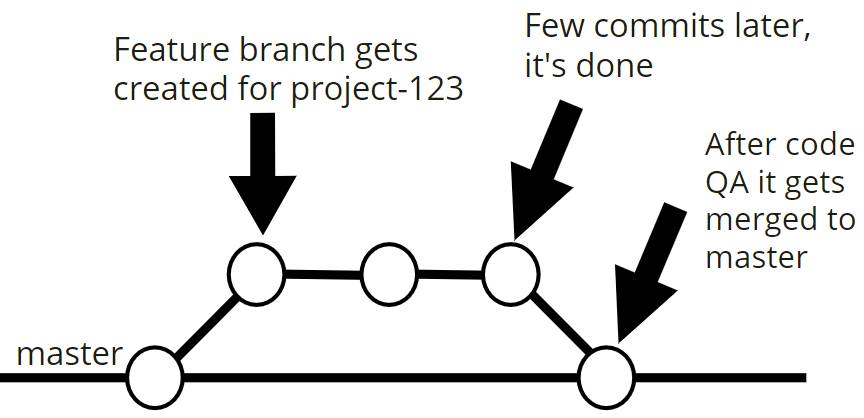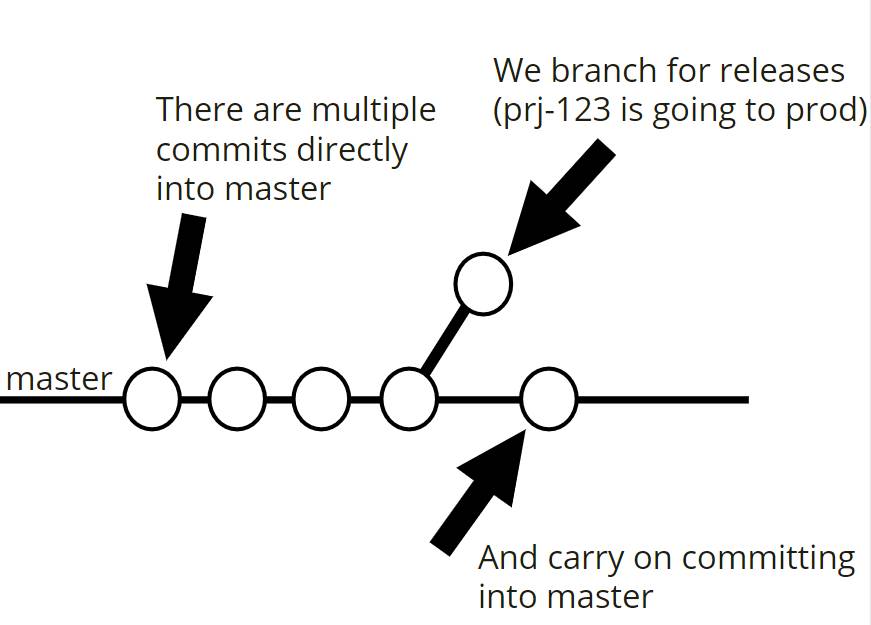包阅导读总结
1. 关键词:Trunk Based Development、Software Development Lifecycle、Release Branching、Strengths、Weaknesses
2. 总结:
本文介绍了软件开发生命周期中两种分支方式,重点阐述了 Trunk Based Development(TBD),包括其工作流程、在大规模场景中的应用、优点和挑战,以及如何用 TBD 进行软件发布,最后指出其有助于缓解长期分支合并的问题。
3. 主要内容:
– 软件开发生命周期(SDLC)在各公司不同
– 版本控制系统、评审流程等均有差异,公司会优化软件开发流程
– 两种分支方式
– 发布分支(Release Branching)
– 开发者基于主分支创建新分支,完成工作后一次性合并到主分支
– 主干开发(Trunk Based Development,TBD)
– 开发者将工作分小批多次合并到主分支,小团队可直接在主分支操作,大团队用短生命周期分支
– TBD 在大规模场景的应用
– 以谷歌为例,TBD 适用于大规模代码库,配合严格的代码 QA 流程,也适用于敏捷方法
– TBD 的优点
– 快速反馈,避免错误工作导致错过期限
– 促进协作文化,增加交流
– 早期集成,促进代码复用
– 便于项目分解和估算时间
– 便于监控和协助初级开发者
– 与持续集成紧密结合
– TBD 的弱点
– 增加破坏主分支的风险
– 提交历史更复杂
– 构建过程慢会耗时
– 依赖特性切换增加调试复杂度
– 团队需频繁从主分支拉取代码以防冲突
– 用 TBD 发布软件
– 发布时分支以提供稳定代码快照,出错时进行修复和合并,有些公司甚至直接发布主分支
思维导图:
文章地址:https://www.freecodecamp.org/news/what-is-trunk-based-development/
文章来源:freecodecamp.org
作者:Kealan Parr
发布时间:2024/6/18 12:55
语言:英文
总字数:1370字
预计阅读时间:6分钟
评分:88分
标签:软件开发,Git,开发流程
以下为原文内容
本内容来源于用户推荐转载,旨在分享知识与观点,如有侵权请联系删除 联系邮箱 media@ilingban.com
The Software Development Lifecycle (SDLC) is different at every company.
The version control system used, peer review process, code review process, design review process, how you do CI, automated testing, and manual testing – all vary greatly depending on where you work.
How a company plans, writes, builds, reviews, deploys, and releases software is optimized for their particular use-case, all with their own strengths and drawbacks in mind.
I started reading about how different big tech companies run their Software Development Lifecycles (SDLC) and heard the term Trunk–Based Development a few times. This is a practice Google follows and I was curious about how it’s different than the way most other companies develop software.
Two Different Ways to Do Branching
Release Branching
There are two common approaches to enable multiple developers to work on one codebase.
The first we’ll refer to as the release branching** method. I’ve also seen it called feature branching**. But both of these same approaches follow the same general pattern.
Usually via Git, developers all clone the codebase (so they all have identical copies on their machines). Then they make a new feature/release branch based on main, and merge as the work is completed. The emphasis here is that they only merge once, at the end, when all the work is complete – and they merge the whole branch into main.
Here’s an overview for how developers use the Release Branch** method:
 Release Branching development workflow visualised.
Release Branching development workflow visualised.
The white dots represent commits, and the bottom solid black line is main. This is a very simple example, as release branches often end up with far more commits than I’ve shown in the diagram (sometimes hundreds).
Developers branch off main, make their changes, and then when it’s complete/has passed code QA, it gets merged back into main. That’s release branching.
Trunk Based Development (TBD)
Trunk-Based Development (TBD) is the second approach. Here, each developer splits the work they will do into small batches and merge into main (which is often referred to as the trunk) multiple times.
In small teams, they normally don’t create a branch and merge the branch into the trunk. They commit directly into the trunk without branches.
In a larger team (with checks and approvals necessary for MR’s), they use short-lived branches. One release branch with 100 commits in TBD would be 10 merge requests with 10 commits each.
In TBD, their code changes generally don’t stay around for more than a few hours. They constantly get merged and integrated with the code everyone else is writing.
Jez Humble is a Site Reliability Engineer at Google, and author of Continuous Delivery, who says “branching is not the problem, merging is the problem” – which is exactly what TBD tries to solve.
It aims to avoid painful merges that so often occur when it is time to merge long-lived branches that have diverged histories from the trunk, or even merge multiple branches together into one from different teams/developers before merging with the trunk.
Does TBD Work at Scale?
In a Google talk, Rachel Potvin, who’s an Engineering Manager at Google, described one codebase that has (as of Jan 2015):
- 1 billion files
- 2 billion lines of code
- 86 terabytes of content
- 45,000 commits per workday
- 15 million lines changed in 250,000 files per week
They used TBD in this codebase and it served their use cases very well. As Google is made up of many talented (most importantly, experienced) engineers, they rarely break their builds.
Google also has a very thorough, strict code QA process (read about it here) which, when using TBD, allows for fast, efficient software delivery.
TBD also works well for Agile methodologies where you have to ship software frequently to get feedback from your consumers/customers. You can continually integrate and get a good snapshot of your current state.
Let’s briefly discuss some TBD strengths.
Strengths of TBD
- Feedback (whether from code QA, or peer review) comes quickly, as you merge daily. This can stop you from doing the wrong thing for 3 weeks, and then getting feedback that your work isn’t correct at the very end, causing you to miss deadlines.
- There’s a mental benefit to TBD, where developers feel like the trunk is our code, rather than everyone having their own feature branches and thinking this branch is my code. This can foster a more collaborative culture, increasing communication.
- It results in early integration with all the other in-flight projects/tickets and helps you promote code re-use. It’s much harder to “use code” that isn’t merged into
mainand you don’t know when will be complete. It also stops merge hell when your 9 month old release branch needs to be merged back into the trunk. - Large projects with lots of work involved are forced to be broken down into smaller deliverables. This is much better for estimating timelines and also for breaking up your code into modular pieces.
- When lots of developers work in isolation on release branches, it can be harder to spot junior developers struggling in their own branch. But if they’re expected to be committing their work daily, you can monitor their daily output and assist them when necessary.
- TBD really cleanly ties in with continuous integration. With lots of small, incremental commits to an eventual finished project, you get an always tested, always integrated codebase with (minimal) horrible merges.
Weaknesses of TBD
- One of the challenges of this approach is that you have an increased chance of breaking the trunk, and stopping lots of people from working. You have to make sure your commits run unit tests along with a good code review process so you don’t lose time reverting commits all day.
- Your commit history into
mainwill likely be more verbose and it can be harder to see if something is wrong. If you are called at 3 AM and asked to fix a bug on your prod site with some dodgy commits that went on during business hours, would you prefer a day with 1 commit or 200 commits? - If you don’t have a fast build process, you will spend a long time waiting for things to build while your team constantly commits.
- Often times with TBD you are incrementally adding new code to do something new, but you also need the “old” paths you’re replacing to still work. Because of this you need to rely on feature toggles (normally from a database) to turn things on and off. This can add an extra level of complexity with debugging.
- A final challenge can be that, when you have constant commits, you are constantly in a state of churn. You need to make sure your team regularly pulls from the trunk and doesn’t end up tripping over one another while merging things.
How to Release Software with Trunk-Based Development
Teams using TBD will typically have a different release process than a team using feature branches.
Generally, if you use release branches, you release main whenever you have something that gets merged in (tickets, completed projects, and so on). Or some teams release main on a schedule, like once every week.
Here’s an overview of how TBD teams do their releases:
 Overview of TBD process
Overview of TBD process
In TBD, branching is used for releases to allow everyone to keep committing into main.
They provide a “snapshot” of your codebase at a stable state, ready for deployment and release.
The only reason the TBD diagram above may need extra details is when something goes wrong with the release of prj-123. Then we commit the result into the trunk and cherry pick the commits into our release branch to get it in a workable state as soon as possible.
Some places, if they are releasing regularly, don’t even branch and can just release the trunk whenever it’s required. It depends on your company oftentimes.
Conclusion
There is a whole site based on the theory and practice of TBD. Feel free to read more here.
I hope this has explained what Trunk Based Development is and why it’s used. It certainly helps alleviate some of the issues around merging long-lived branches containing major rewrites.
I share my writing on Twitter if you enjoyed this article and want to see more.
